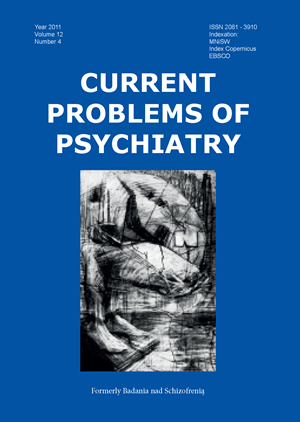Objawy zagrożenia i uzależnienia od telefonu komórkowego mierzonego Kwestionariuszem do Badania Uzależnienia od Telefonu Komórkowego, autorstwa Potembskiej i Pawłowskiej u młodzieży Polskiej w wieku od 13 do 24 lat
Słowa kluczowe:
uzależnienie od telefonu komórkowego,, młodzieżAbstrakt
Celem pracy było określenie rozpowszechnienia zagrożenia i uzależnienia od Internetu u młodzieży w wieku 13-24 lat, na podstawie wyników Kwestionariusza do Badania Uzależnienia od Telefonu Komórkowego, autorstwa Pawłowskiej i Potembskiej.
Grupa badana: Badania przeprowadzono w latach 2010-2011 i objęto nimi 694 młodzieży w wieku od 13 do 24 roku życia. Do liceum uczęszczało 206 osób (67 chłopców i 139 dziewcząt), do gimnazjum uczęszczało 113 uczniów (48 chłopców i 65 dziewcząt), studiowało 375 osób (123 mężczyzn i 252 kobiety).
Metody: W pracy zastosowano Ankietę socjodemograficzną oraz Kwestionariusz do Badania Uzależnienia od Telefonu Komórkowego (KBUTK), autorstwa Potembskiej i Pawłowskiej. KBUTK składa się z 33 pytań. Współczynniki rzetelności dla poszczególnych skal są wysokie i wynoszą: dla skali Akceptacji i bliskości alfa Cronbacha=0,91; dla skali Uzależnianie od funkcji aparatu telefonicznego alfa Cronbacha=0,81; dla skali Uzależnienie od SMS i rozmów alfa Cronbacha=0,85; dla skali Komunikacja pośrednia alfa Cronbacha=0,83. Współczynnik rzetelności dla wyniku ogólnego KBUTK wynosi 0,91. Wykonano test-retest w odstępie miesiąca na grupie 65 osób i uzyskano dla poszczególnych skal następujące współczynniki korelacji: dla skali Akceptacja i bliskość rtt=0,79, (p<0,001); Uzależnienie od aparatu telefonicznego rtt=0,78, (p<0,001); dla skali Uzależnienie od rozmów i wiadomości SMS rtt=0,81, (p<0,001) a dla skali Komunikacja pośrednia rtt=0,74, (p<0,001). Wynik dla skali ogólnej wynosił rtt=0,79; (p<0,001).
Wyniki: Badani uzyskali średni wynik w KBUTK równy 28 punktów, przy odchyleniu standardowym równym 19 punktów. Wynik najniższy w skali ogólnej KBUTK wynosił 0, a najwyższy 121 punktów (na 132 punktów możliwych do uzyskania). Za osoby zagrożone uzależnieniem od telefonu komórkowego uznano te, które uzyskały w skali ogólnej KBUTK wyniki mieszczące się w przedziale od 31 do 69 punktów (w granicach – od wyniku średniego do plus 2 odchylenia standardowego od średniej), a za osoby uzależnione uznano badanych, którzy uzyskali wynik równy lub powyżej 2 odchylenia standardowego od średniej (70 punktów i powyżej).
Z grupy 694 badanych 2,9% spełniało kryteria uzależnienia od telefonu komórkowego (uzyskali 70 lub więcej punktów – powyżej 2 odchylenia standardowego od średniej) a 35,3% spełniało kryteria zagrożenia uzależnieniem od telefonu komórkowego (uzyskali od 31 do 69 punktów – przedział od średniej do 2 odchylenia standardowego od średniej).
Z grupy 456 kobiet kryteria uzależnienia, mierzone Kwestionariuszem KBUTK, spełniało 2,9%, a zagrożenia uzależnieniem od telefonu komórkowego – 35,1% badanych. Z grupy 238 mężczyzn, uzależnionych było 2,5% badanych, a kryteria zagrożenia uzależnieniem od telefonu komórkowego spełniało 30,3%.
Wnioski: 1. Więcej kobiet niż mężczyzn spełnia kryteria uzależnienia i zagrożenia uzależnieniem od telefonu komórkowego. 2. W Polsce kryteria uzależnienia od telefonu komórkowego spełnia ok. 3% młodzieży (2,9% kobiet i 2,5% mężczyzn), a zagrożenia tym uzależnieniem 35% osób (35% kobiet i 30,3% mężczyzn).
Bibliografia
1. Griffiths M.D. Gambling on the internet: a brief note. J. Gambl. Stud., 1996; 12: 471-473.
2. Young K., Internet can be a addicting as alcohol, drugs and gambling, says new research. Pittsburgh: University of Pittsburgh Press; 1996.
3. Potembska E., Pawłowska B. Właściwości psychometryczne Kwestionariusza do Badania Uzależnienia od Telefonu Komórkowego (KBUTK). Bad. Schizofr., 2009; 10: 322-329.
4. Martinotti G., Villella C., Di Thiene D., Di Nicola M., Bria P., Conte G., Cassano M., Petruccelli F., Corvasce N., Janiri L., La Torre G. Problematic mobile phone use in adolescence: a cross-sectional study. J Public Health, 2011; DOI 10.1007/s10389-011-0422-6.
5. Jenaro C., Flores N., Gómez-Vela M., Gonz|lez-Gil F., Caballo, C. Problematic Internet and cell-phone use: Psychological, behavioral, and health correlates. Addiction Research & Theory, 2007; 15(3): 309-320.
6. S|nchez-Martínez M., Otero A. Factors associated with cell phone use in adolescents in the community of Madrid (Spain). Cyberpsychol Behav. 2009 Apr;12(2):131-7.
7. Yen CF, Tang TC, Yen JY,. Lin H.C, Huang C.F., Liu S.C., Ko C.H. Symptoms of problematic cellular phone use, functional impairment and its association with depression among adolescents in southern Taiwan. J. Adolesc., 2009; 32: 863-873.
8. Yang YS, Yen JY, Ko CH, Cheng CP, Yen C.F. The association between problematic cellular phone use and risky behaviors and low self-esteem among Taiwanese adolescents. BMC Public Health 2010; 10: 217-223.


